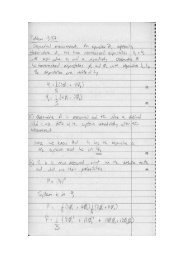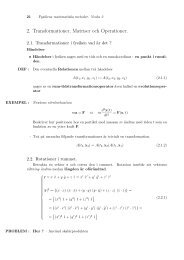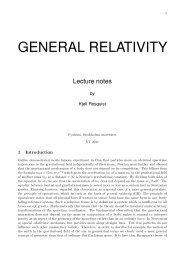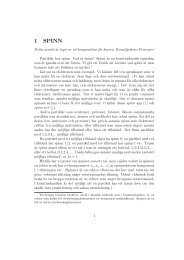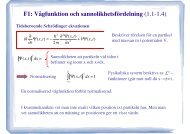Solutions chapter 4 - Cosmology and particle astrophysics
Solutions chapter 4 - Cosmology and particle astrophysics
Solutions chapter 4 - Cosmology and particle astrophysics
You also want an ePaper? Increase the reach of your titles
YUMPU automatically turns print PDFs into web optimized ePapers that Google loves.
<strong>Solutions</strong> <strong>chapter</strong> 4 - <strong>Cosmology</strong> <strong>and</strong> <strong>particle</strong> <strong>astrophysics</strong><br />
4.4 Einstein’s equations are<br />
Rµν − 1<br />
2 gµνR − Λgµν = 8πGTµν, (1)<br />
where the Ricci tensor Rµν <strong>and</strong> the Ricci scalar R = g µν Rµν are functions of derivatives of the<br />
metric <strong>and</strong> it’s inverse. The constant Λ is the so-called cosmological constant <strong>and</strong> it has usints of<br />
the inverse of length squared.<br />
The stress energy tensor for a perfect fluid is given by eq. (4.13) in Bergström <strong>and</strong> Goobar:<br />
Tµν = (p + ρ) uµuν − pgµν<br />
where uµ is the four-velocity of the fluid element (<strong>and</strong> as such, it will depend on the observer!).<br />
Evaluated in the rest frame of the fluid, where u µ = (1, 0, 0, 0) <strong>and</strong> gµν = ηµν, this becomes<br />
⎛<br />
ρ<br />
⎜<br />
Tµν = ⎜ 0<br />
⎝ 0<br />
0<br />
p<br />
0<br />
0<br />
0<br />
p<br />
0<br />
0<br />
0<br />
⎞<br />
⎟<br />
⎠ . (3)<br />
0 0 0 p<br />
If we move the cosmological constant to the right h<strong>and</strong> side of eq. (1), we see that we can define<br />
an effective stress energy tensor for the cosmological constant:<br />
T Λ µν = Λ<br />
8πG gµν.<br />
If we evaluate this in a frame where gµν = ηµν <strong>and</strong> compare with eq. (3), we see that we can<br />
identify<br />
ρΛ = Λ<br />
8πG , pΛ = − Λ<br />
8πG = −ρΛ. (4)<br />
The Robertson-Walker metric is<br />
ds 2 = dt 2 − a (t) 2<br />
dr 2<br />
1 − kr 2 + r2 dΩ 2<br />
(2)<br />
<br />
. (5)<br />
Using this metric, together with the perfect fluid form of the stress energy tensor, in Einstein’s<br />
equations, gives the following two equations:<br />
2ä<br />
a +<br />
2 ˙a<br />
a<br />
+ k 8πG<br />
=<br />
a2 3 ρtot, (6)<br />
2 ˙a<br />
+<br />
a<br />
k<br />
a2 = −8πGptot. (7)<br />
Here we have included the cosmological constant in the energy density <strong>and</strong> pressure:<br />
ρtot = ρm + ρrad + ρΛ, (8)<br />
ptot = pm + prad + pΛ. (9)<br />
1
Eq. (6) is the 00-component of Einstein’s equations, where as the second equation comes from<br />
the spatial component.<br />
independent equation.<br />
Notice that by isotropy, the spatial component can only give us one<br />
By construction, the left h<strong>and</strong> side of Einstein’s equation has a vanishing divergence:<br />
<br />
Rµν − 1<br />
2 gµνR<br />
<br />
− Λgµν = 0. (10)<br />
This means that the right h<strong>and</strong> side must also have vanishing divergence:<br />
;ν<br />
T µν ;ν = 0. (11)<br />
Using the Robertson-Walker metric <strong>and</strong> the perfect fluid form of the stress energy tensor then<br />
gives<br />
˙ρ + 3H (ρ + p) = 0, (12)<br />
which has the physically meaning of: “a change in the energy density equals the flow of energy<br />
density into that region.” Notice that we need to include pressure here, since pressure is a form of<br />
energy. The factor 3H appears in a lot of places in cosmology, <strong>and</strong> it can be viewed as a measure<br />
of how much a three-volume changes due to the expansion of space.<br />
Before we start to manipulate Einstein’s equation, we try to solve eq. (12). Introducing an<br />
equation of state<br />
p = wρ (13)<br />
casts the continuity equation in the form<br />
or<br />
which can be solved to give<br />
˙ρ + 3H (1 + w) ρ = 0 (14)<br />
dρ 1<br />
dt ρ<br />
da 1<br />
= −3 (1 + w)<br />
dt a<br />
ρ ∼ a −3(1+w)<br />
where the proportionality constant depends on how large the energy density is at a given some<br />
given time.<br />
If we now take the difference between the two Einstein equations, we get<br />
(15)<br />
(16)<br />
ä<br />
= −4πG (ρ + 3p) . (17)<br />
a 3<br />
Notice how the curvature term ka −2 dropped out. This means that we can solve for the evolution<br />
of a as a function of the energy density <strong>and</strong> pressure (which are related by the equation of<br />
state), <strong>and</strong> then set initial conditions according to the 00-equation (which includes the curvature).<br />
Using eq. (16) <strong>and</strong> the equation of state in eq. (13) turns the left h<strong>and</strong> side into (we now use a<br />
proportionality constant in the equations)<br />
or<br />
Using the ansatz a (t) ∼ t β then gives<br />
or<br />
ä<br />
∼ a−3(1+w)<br />
a<br />
(18)<br />
ä ∼ a −2−3w . (19)<br />
t β−2 ∼ t −(2+3w)β , (20)<br />
β =<br />
2<br />
3 (1 + w)<br />
2<br />
(21)
so<br />
2<br />
a (t) ∼ t 3(1+w) . (22)<br />
Notice that if w = −1 we would not be able to determine β, which tells us that our ansatz was<br />
not good. Instead, we would get the equation<br />
with solution<br />
ä ∼ a (23)<br />
a ∼ exp (±At) , (24)<br />
for some constant A with units of s −1 (which from the Friedmann equation can be determined to<br />
be equal to<br />
Λ<br />
3 ).<br />
4.7 The Hubble function is given from Einstein’s equation as<br />
H (t) 2 ≡<br />
2 ˙a<br />
=<br />
a<br />
8πG<br />
3 (ρm + ρvac) − k<br />
a2 = 8πG<br />
3 ρm + Λ k<br />
− . (25)<br />
3 a2 We know that the matter scales as the inverse cube of the scale factor, so we can write<br />
ρm = ρ0a3 0<br />
3 , (26)<br />
a (t)<br />
where a0 is the scale factor today <strong>and</strong> ρ0 is the matter density today. If we now define<br />
ΩM ≡ 8πGρ0<br />
3H2 , ΩΛ ≡<br />
0<br />
Λ<br />
3H2 , ΩK ≡<br />
0<br />
−k<br />
a2 0H2 , (27)<br />
0<br />
where H 2 0 is the value of the Hubble function today, we can write the Hubble function as<br />
For the redshift we have that<br />
H (t) 2 = H 2 0<br />
= H 2 0<br />
= H 2 0<br />
<br />
8πG<br />
3H 2 0<br />
<br />
ΩM<br />
8πG<br />
ρ0a 3 0<br />
a (t)<br />
3H 2 0<br />
a 3 0<br />
ρm + Λ<br />
3H 2 0<br />
3H 2 0<br />
3 + Λ<br />
− k<br />
H 2 0 a2 0<br />
− k<br />
H 2 0 a2<br />
a 2 0<br />
a (t) 3 + ΩΛ + ΩK<br />
a (t) 2<br />
a 2 0<br />
<br />
a (t) 2<br />
<br />
<br />
. (28)<br />
a0<br />
= 1 + z, (29)<br />
a (t)<br />
which means that we can finally write the Hubble function as<br />
<br />
ΩM (1 + z) 3 + ΩΛ + ΩK (1 + z) 2<br />
. (30)<br />
H (t) 2 = H 2 0<br />
Notice that we have neglected the contribution from radiation, which should be perfectly fine for<br />
z < 1000.<br />
3
4.11 We assume a “st<strong>and</strong>ard” cosmology with<br />
Volumes in the universe will change as<br />
ΩM + ΩR = 1, ΩΛ = 0, (31)<br />
H0 = 65 km s −1 Mpc −1 . (32)<br />
V (t) = V0<br />
a (t)<br />
a0<br />
3<br />
, (33)<br />
where V0 is the given volume today <strong>and</strong> a0 is the scale factor today. The Hubble function is<br />
H 2 = H 2 0<br />
= H 2 0<br />
<br />
ΩM<br />
<br />
ΩM (1 + z) 3 + ΩR (1 + z) 4<br />
For an order of magnitude estimate, we can drop ΩR. Using H = ˙a<br />
a<br />
or<br />
3 <br />
3<br />
a0<br />
a0<br />
+ ΩR . (34)<br />
a (t) a (t)<br />
˙a 2 = H2 0 ΩM a 3 0<br />
a (t)<br />
da<br />
dt<br />
we get<br />
(35)<br />
∼ 1<br />
√ a . (36)<br />
Notice that we drop the numerical factor here: It doesn’t matter since we only need to compute<br />
the relative change in the scale factor. The above differential equation can be solved to give<br />
or<br />
We thus get<br />
a (t) ∼ t 2/3<br />
a (t) = a0<br />
V (t) = V0<br />
t<br />
t0<br />
t<br />
(37)<br />
2/3<br />
. (38)<br />
t0<br />
2<br />
. (39)<br />
We now need to determine V0 <strong>and</strong> t0. The age of the universe is given by integrating equation<br />
(4.77):<br />
t0 = H −1<br />
ˆ∞<br />
dz 2<br />
0<br />
= . (40)<br />
5/2<br />
(1 + z) 3H0<br />
0<br />
The volume of the observable universe is given by the <strong>particle</strong> horizon, which tells us how far a<br />
photon can have travelled since t = 0. It is given by equation (4.89):<br />
ˆ<br />
dH (t) = a (t)<br />
Since we want to study this for t = t0 this becomes<br />
dH (t0) = a0<br />
ˆt0<br />
0<br />
a0<br />
t ′<br />
t0<br />
0<br />
t<br />
dt ′<br />
a (t ′ . (41)<br />
)<br />
dt ′<br />
= 3t0 =<br />
2/3 2<br />
. (42)<br />
4<br />
H0
The volume is then V0 ∼ [dH (t0)] 3 ∼ t 3 0 (notice that we are using a order of magnitude estimate,<br />
since we have neglected the contribuation from ΩR anyways) <strong>and</strong> we thus get<br />
V (t) ∼ t0t 2 ∼ t2<br />
To get the right unit we must also put in a factor of c 3 here:<br />
V (t) ∼ c3 t 2<br />
Now comes the difficult part: Plugging in actual numbers. We have<br />
This gives<br />
H0<br />
H0<br />
. (43)<br />
. (44)<br />
c = 3 × 10 8 m s −1 , H0 = 2 × 10 −18 s −1 , t = 10 −3 s. (45)<br />
V t = 10 −3 s ∼ 10 37 m 3 . (46)<br />
We can compare this to our estimate of the observable universe today, which is<br />
4.13 We have the relation<br />
V0 ∼ c 3 t 3 0 ∼ 10 78 m 3 . (47)<br />
m (z) = M + 5 log 10 dL (z) + 25 (48)<br />
where m is the apparent magnitude, M the absolute magnitude (the apparent magnitude if the<br />
object is at 10 parsec from the observer) <strong>and</strong> dL is measured in Mpc. Solving for dL gives<br />
For our values we have<br />
which gives<br />
dL = 10 m−M−25<br />
5 Mpc. (49)<br />
m = 18, M = −17, (50)<br />
dL = 10 18+17−25<br />
2 Mpc = 100 Mpc. (51)<br />
5


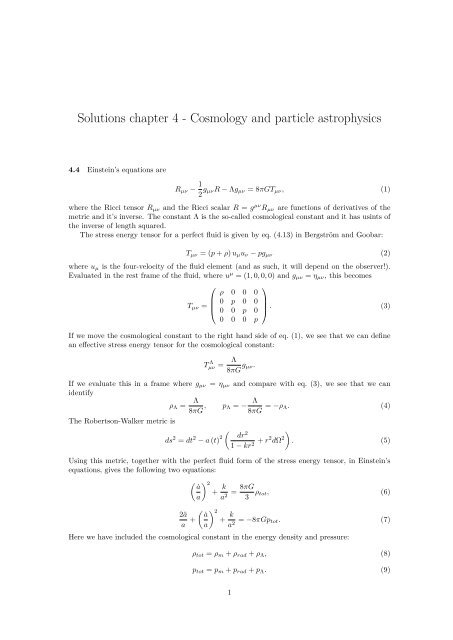
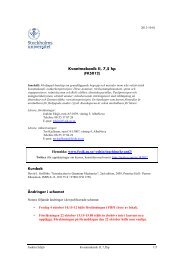
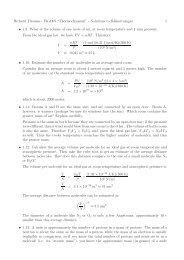
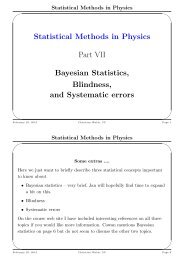
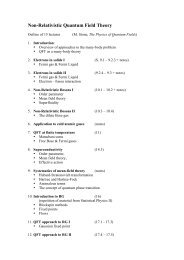
![Final Examination Paper for Electrodynamics-I [Solutions]](https://img.yumpu.com/21085948/1/184x260/final-examination-paper-for-electrodynamics-i-solutions.jpg?quality=85)

